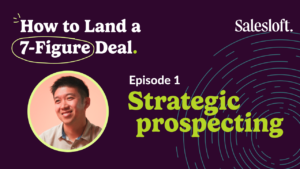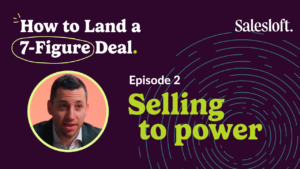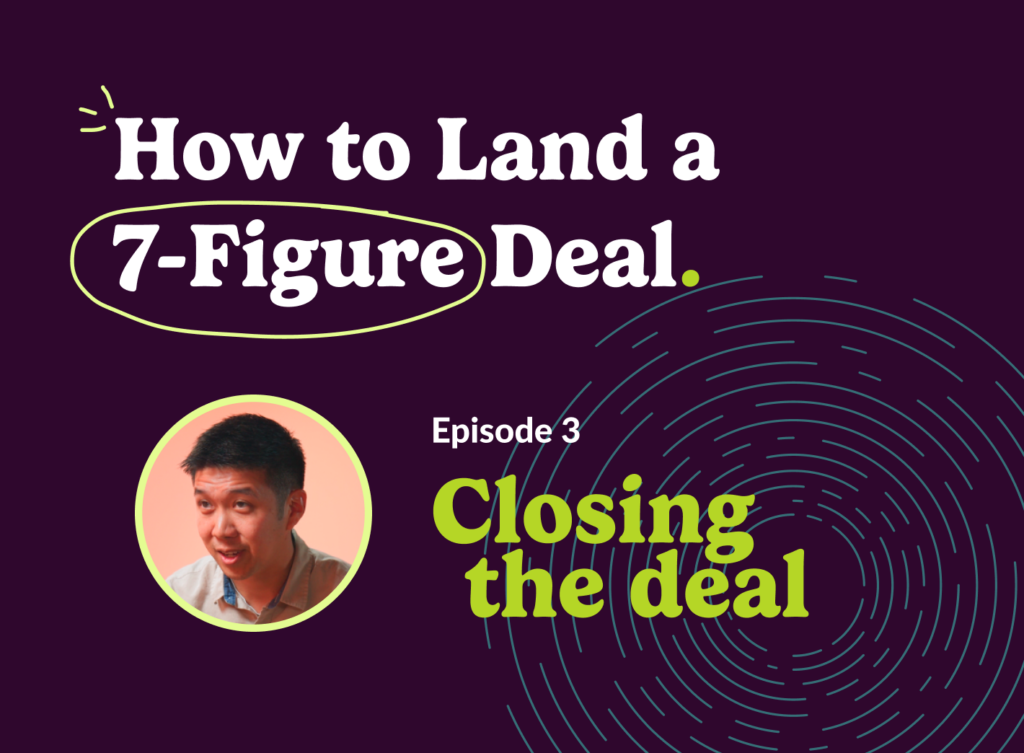In this three-part series, you’ll learn how a Salesloft AE lands multiple mega deals — from prospecting to selling to power, to delighting them as customers — so you can replicate his success.
The customer is on board. The contract is signed. The team is popping champagne. Now what?
In this last interview of the 7-figure deal series, Salesloft’s Director of Product Marketing Albert Rhee asked Corey Goldstein the tactics he uses to maintain value after a big deal is done. In this episode, Corey explains why you need a strong vision, a strategic foundation, and a lot of patience.
This interview has been edited for clarity.
Albert:
Alright Corey, I’m curious to know. Once the ink is dry and the contract is signed, what goes through your mind when you actually close a 7-figure deal?
Corey:
I’m set for life, man! I’m good!
Joking aside, I think it’s the culmination of a lot of hard work. It feels good for a week, maybe, and then I’m ready for the next one. That initial feeling’s awesome! It wears off kind of quickly, unfortunately. But when the commission check clears, that feels good! I’ll say that.
Albert:
We have a tradition at Salesloft with big enterprise wins. There’s a letter of gratitude from the primary seller written to the rest of the team. What was it like writing that?
Corey:
That felt good. A lot of the time, yes, I get the commission check, and I get a lot of the credit for being the seller. But obviously you can’t sell a multi-million dollar deal by yourself — especially at the size of the deals that we’re talking about today. These were global deals. And I did not fly to India or Japan or China, but people on our team did.
That’s where I really try to go above and beyond and genuinely thank them. Because the only way I meet my goal at the end of the day is from all their hard work and how they genuinely care about the customer.
Albert:
Compared to a 6-figure deal, what is the difference in the cycle time between deals of those scales?
Corey:
A lot! I think with the existing customer I sold, I inherited them about two years before I ever sold a dime to them. So that was a long process. But what I did well at the beginning was that I had no expectation of selling them 50k here and 70k there. What I wanted from them was this big, transformational deal. So from the very beginning, when I took them over as a customer, my thought process was, how do I build the foundation?
Albert:
So you had the vision, which gave you the patience to actually execute on that?
Corey:
I think “vision” is the perfect word. And really translating that vision over to their executives. So, when the CFO asks, why the bleep are we spending over a million dollars on this technology we’ve never used before, your champion needs to be empowered to say, “Here’s why,” and push across the business case or have a really good answer to that.
When all the questions come up from procurement and legal and IT and the budget holders, the champion needs to be able to quell their concerns with the vision that you implanted into their brain.
Albert:
Now that the ink has dried on a couple of these big deals that you landed this past year, are you still involved post-sales? What is that like with the customer after the contract is signed?
Corey:
Yeah, very involved! I think what a bad sales rep would do is run away with their commission check and look back and say, “See you guys later! I got what I needed.”
But I think part of what happened with these deals is you build relationships over time, and the champions are taking a big risk by putting their name on the line for you. I feel indebted to them and saying, “Okay, I promised you X, Y, and Z. I’m going to be there to see it through.”
Any of my champions could move to a new company, and their first call could be to me. So I want to do right by them for the future of my career to say —and the future of Salesloft. My champions should think, “This person did right by me and didn’t just leave me at the altar after, you know, bringing me all the way here.
Albert:
Someone once described to me how enterprise deals are like being on a rollercoaster for 20 months. What’s one moment that was the scariest part of the deal? Or when you felt like things were potentially unraveling? What was that like, and how did you address it?
Corey:
For one of the deals, it got to a point where we were about 90 percent of the way there, then it started getting really quiet. We were texting. We were Slacking. We were emailing them. And then they weren’t responding.
At that point, I got in my head like, wow, I worked 19… 20 months to get this deal done. And is this not going to happen? And so when that happened, I took a step back and got perspective. I asked myself, “Okay, why is this happening?” And I began to realize there’s challenges on their side that they haven’t solved yet that are actually necessary for them to fix before they implement something like Salesoft.
So tough conversations had to happen. Forecasts that were locked in, or in dark pen that was hard to erase, and had to be ripped up. But at the end of the day, I think any good sales leadership knows that you can’t force a company to buy. You have to really wait for the right time and jump on the right urgency.
When things then resurfaced two months later, we’d already been through it and we knew that this was our time. Luckily, things got inked at the right time.
Albert:
What’s one last takeaway you have for our audience?
Corey:
The biggest thing I can always say is, if you’re not tied to their strategic objectives at a company level, you are not going to get a 7-figure deal done.
What I always say is, if you’re talking about low level things, you’re going to meet with low level people. If you’re talking about high level things, you’re going to meet with the higher-ups.
The truth is we’re going to help them achieve their CEO and their board of directors goals. And if you can do that, you can sell seven figures of software. If you can’t do that, and you’re only solving small problems that are on a director or VP level, you’re going to sell. Tens of thousands or hundreds of thousands of dollars of software instead of millions.
Check out the rest of the series
The road to 7-figure deals is paved with vision, patience, and a whole lot of help from your team and champions. Landing those big enterprise wins is definitely doable, though. And if you follow all of Corey’s advice, you’ll be well on your way to those multi-million dollar wins soon. Miss the first interviews in the series? Check out part #1 on bottoms up prospecting and part #2 on selling to power. Then subscribe to our YouTube channel to get notified about the latest and greatest sales strategies.
 |
 |


